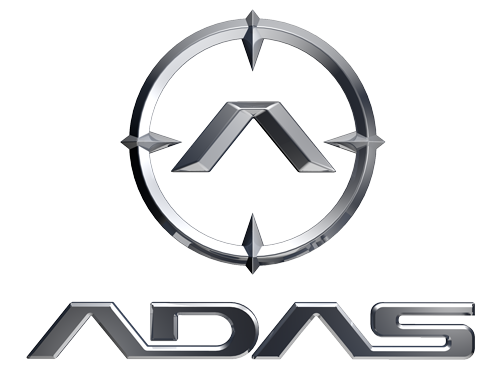New cars are equipped with Advanced Driver Assistance Systems (ADAS). These modern safety systems use sensors to collect information about the vehicle’s environment. The sensors gather data to issue safety alerts. For the driver’s safety, ADAS can even use sensor data to determine whether to temporarily manage a vehicle’s brakes or steering. Vehicle ADAS sensors, like all other sensors, are only as accurate as their calibration allows. This is where ADAS calibration comes in, a rapidly growing necessity in the automotive industry.
What is ADAS Calibration?
To understand what calibration is, we must first answer the question: “What is a driver assistance system?” ADAS stands for Advanced Driver Assistance Systems. These are automotive safety devices composed of a number of systems and sensors that serve to improve driver safety.
When a vehicle is damaged and repaired, these systems need to be recalibrated to the state they were in before the accident to ensure they function as intended.
The precise physical alignment, testing, and electronic orientation of sensors that collect data to inform your vehicle’s Advanced Driver Assistance Systems (ADAS), such as Forward Collision Warning (FCW), Lane Departure Warning (LDW), Automatic Emergency Braking (AEB), and others, are known as ADAS system calibration (and recalibration).
ADAS sensors are carefully installed in their standard location at the factory in a brand new vehicle. All sensors point to the same precise location. However, events such as accidents, minor collisions, repairs, or component replacements can cause sensor misalignment over the life of a vehicle. Vehicles equipped with an ADAS camera located on the windshield, for example, will need to be calibrated once the windshield is replaced.
Unfortunately, not all ADAS sensors have self-diagnostic capabilities that alert the driver when they are not calibrated. To ensure that a vehicle’s ADAS systems are functioning properly, automotive specialists must understand and follow manufacturers’ calibration requirements.
Why ADAS Calibration?
ADAS system calibration is a critical step to ensure that the sensors and cameras of ADAS systems are properly aligned with each other. Without proper calibration, the ADAS system may be unable to correctly detect and respond to its environment. A poorly aligned or improperly calibrated ADAS system can lead to major performance and safety issues.
For example, if the cameras are not properly calibrated, the system may struggle to recognize elements in its environment. The system may then fail to identify obstacles in the vehicle’s path, increasing the risk of collision. Similarly, if the radar system is not properly calibrated, it may identify elements that are not present, resulting in false alerts and significant driver distraction.
Failure to calibrate driver assistance systems can lead to accuracy issues, as the system fails to identify small or medium-sized objects in its path. A sensor that cannot properly assess the environment around a vehicle is of no value; this is why proper calibration of ADAS sensors is essential for safe driving.
ADAS Equipment Requiring Calibration:
Cameras:
Many cars use front camera systems for adaptive cruise control, automated emergency braking, lane-keeping assistance, lane departure warning, and automatic high beams.
They are visible in most vehicles and are located inside the windshield, in the roof, or in the mirrors. The technology is comparable to that of a digital camera, but the visual processing of the cameras is more advanced. As digital data points are continuously collected, the ADAS interprets data from the camera system to control safety devices if an urgent threat is recognized.
When replacing a windshield, many car manufacturers require glass from original equipment manufacturers (OEM). This ensures that no camera systems are affected when looking through the glass to observe the environment.
Radar sensors – front and rear:
These sensors are used in adaptive cruise control, automated emergency braking systems, and collision warning systems (ADAS) in automobiles. They use basic measurements of time, distance, and speed. A wave is sent and returned as a high-frequency radio signal to determine the distance between an object and the vehicle.
They are hidden under the vehicle’s grille or front emblem, or inside the front camera housing. It is more difficult to know if your vehicle is equipped with a front radar sensor, although it may be visible under the hood or by inspecting the dashboard and user manual for adaptive cruise control, emergency braking, or front collision alert functions.
Rear sensors are located on the side mirrors or on the rear bumpers and taillights. They can detect rear cross-traffic and warn cars when backing out of a parking space. This is a sensitive location, and car manufacturers often prohibit repairs in areas in front of the sensors. These sensors also require custom coatings. Make sure nothing interferes with signal transmission. Even thick paint can distort a sensor’s signal, which is why bumper stickers should not be used near sensor locations.
Ultrasonic sensors:
These are small circular sensors mounted on the front and rear bumpers of vehicles and used for parking assistance systems. They do not require calibration as such. Instead, they depend on the mounting position. Car manufacturers prohibit the use of aftermarket bumpers or refurbished components, as they may differ from the original item.
Conclusion:
ADAS technology is gradually becoming a fundamental aspect of contemporary automobiles, offering drivers a variety of enhanced safety features. However, the safe and reliable operation of the system heavily depends on accurate calibration. If sensors and cameras are not properly calibrated, an ADAS system may be unable to effectively identify surrounding objects, posing a major safety hazard. This is why drivers should prioritize professional calibration of ADAS systems and stay informed about the latest advances in automotive technology. By doing so, drivers can ensure their vehicle is equipped with the most up-to-date technologies and that they are safe on the road.
